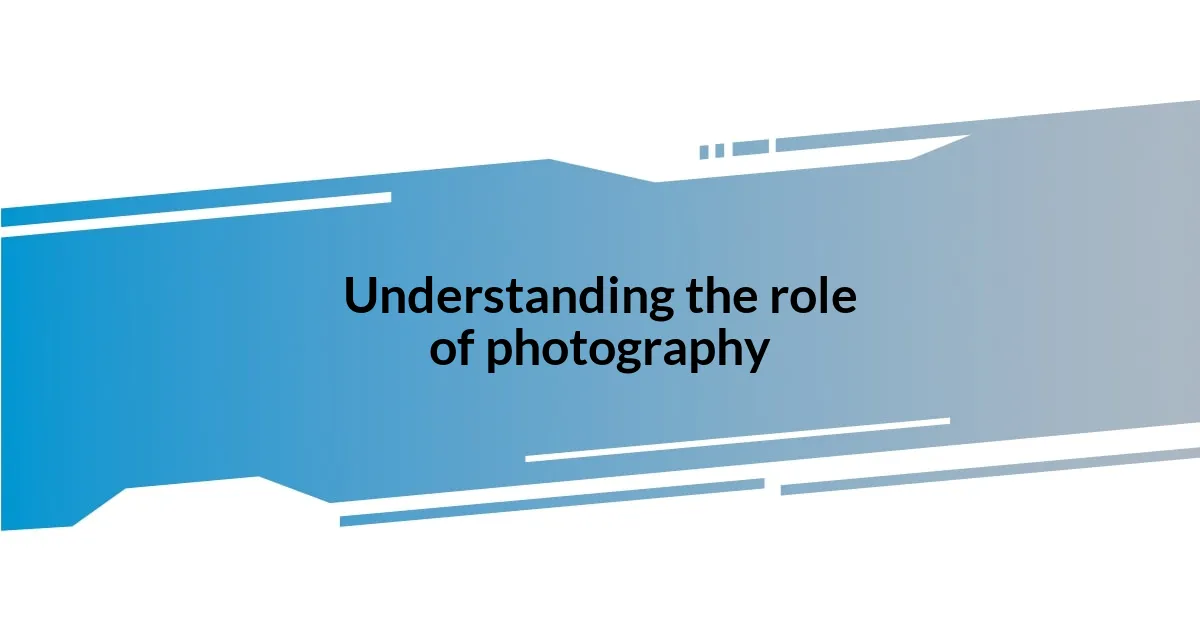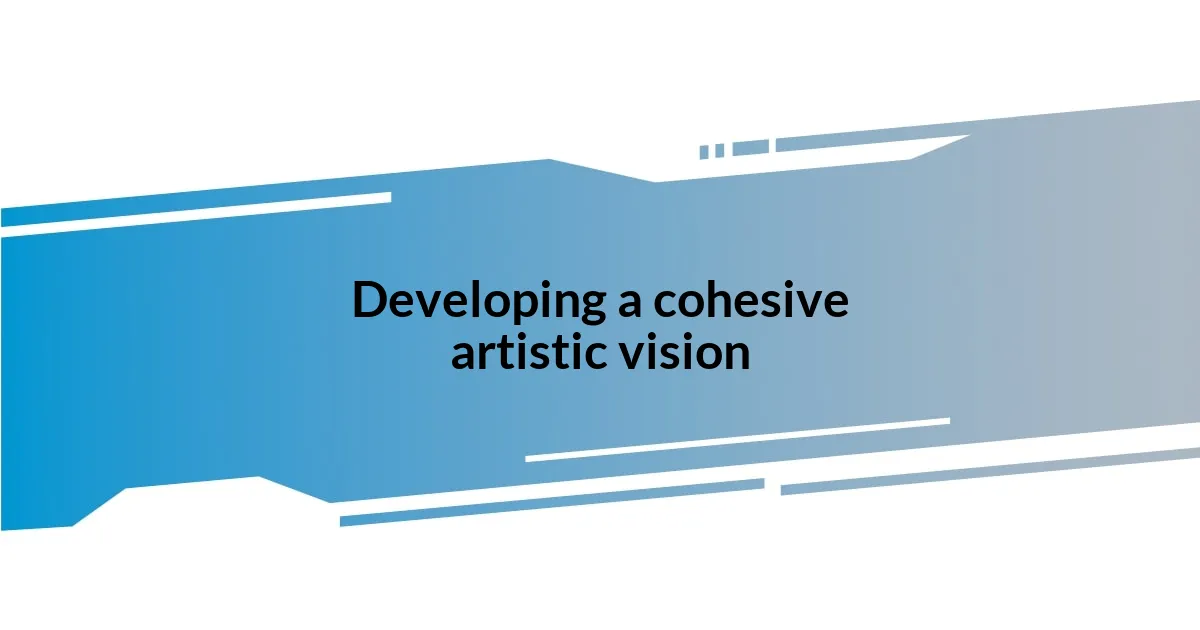Key takeaways:
- Photography enhances artistic expression by capturing emotions and creating conversations that deepen viewer engagement.
- Choosing the right photography style significantly impacts the narrative and emotional depth of the artwork, encouraging exploration and intuition.
- Creating mixed media pieces allows for the integration of diverse materials, enhancing storytelling and inviting viewer connection through layered experiences.

Understanding the role of photography
Photography serves as a powerful tool for me, allowing me to capture fleeting moments and emotions that might otherwise be lost. I remember a time when I spotted a stunning sunset while hiking; in that split second, I knew that taking a photo was essential. That image didn’t just preserve the day; it captured the feeling of awe I experienced, making it a permanent part of my art.
When I incorporate photography into my creative process, it opens doors to explore different perspectives and narratives. Have you ever considered how a simple photograph can evoke a multitude of emotions? I often find that an image can convey complex stories that enhance my artwork in ways that paint alone cannot. Each shot is like a conversation starter, inviting viewers to look deeper into my artistic intent.
Moreover, photography acts as a bridge between reality and imagination. For instance, I love experimenting with contrasting colors and textures in my photos. This blend stimulates my creativity, urging me to envision new ways to express a theme or concept. In this way, photography is not just an accompaniment to my art; it’s a vital part of my artistic journey that continuously inspires and challenges me.

Choosing the right photography style
Choosing the right photography style is crucial for enhancing my art. In my experience, selecting a style that resonates with my artistic vision can dramatically change the entire feel of a piece. For example, I once tried a vintage filter on photos I planned to use in a mixed media project, and it created such a nostalgic mood that the final artwork felt like a journey back in time. This transformation taught me that the right style can breathe life into my concepts.
I’ve experimented with various styles, from minimalism to more dramatic, high-contrast photography. Each approach brings something unique to the table. One day, while practicing street photography, I stumbled upon an urban scene filled with shadows and vibrant colors. That spontaneous shot, captured in a candid moment, ignited a whole series where I explored the interplay of light and shadow in my subsequent art pieces. It was as if that one choice in style opened a new path for my creativity.
Finding your right photography style might seem daunting, but it’s all about exploration and intuition. Ask yourself, what emotions do you want to convey? I recall a time when I was drawn to black-and-white photography; it allowed me to focus on shapes and emotions rather than colors. It was a beautiful exercise in stripping down distractions, leading to some of my most profound reflections in art. Sometimes, the style that makes your heart race is the one that will elevate your work the most.
| Photography Style | Description |
|---|---|
| Minimalism | Focuses on simplicity and clean lines, emphasizing the subject without distractions. |
| Vintage | Utilizes filters or techniques that replicate old photographs, evoking nostalgia. |
| High-Contrast | Emphasizes stark differences between light and dark, creating dynamic images. |
| Documentary | Captures real-world events or environments, telling a story through images. |
| Abstract | Focuses on shapes, colors, and forms rather than the subject itself, creating open interpretation. |

Developing a cohesive artistic vision
When developing a cohesive artistic vision, I often reflect on the common threads that run through my work. It’s like piecing together a puzzle; each photo I take serves a purpose in the larger narrative I wish to convey. For instance, I remember a series of portraits I did that revolved around the theme of vulnerability. I sought out individuals who were willing to share their stories, and as I engaged with them, the images began to capture not just their faces, but the emotions and experiences they carried. This connection between subject and viewer helped me create a unified artistic expression that resonated deeply.
- Define the core themes that resonate with you.
- Explore how photography can accentuate these themes.
- Reflect on your emotions and experiences that inform your art.
- Look for patterns and connections in your photographic choices.
- Continually revisit and refine your vision as you grow as an artist.
Embracing the evolution of my style has also been critical in achieving cohesion. I recall a time when I immersed myself in a nature-inspired project, exploring textures and forms in the landscape. The visual language I developed during this phase didn’t only reflect the beauty of nature but also sparked a more profound exploration of decay and renewal in my subsequent pieces. That connection between my photographic style and subject matter not only unified that project but also set the stage for my ongoing artistic dialogue. It taught me how essential it is to remain attuned to how each element of my work contributes to the overarching narrative.

Creating unique mixed media pieces
Creating mixed media pieces has become one of my favorite artistic endeavors, allowing me to bridge the gap between photography and other mediums. I vividly recall my first attempt at layering photographs with watercolor splashes. The intention was to capture the fluidity of emotion versus the starkness of reality. When I saw how the soft hues danced around the sharp edges of my photo, I felt a rush of excitement. This layering enhanced the depth of the story I wanted to tell, demonstrating how different mediums can create a dynamic conversation.
I often find inspiration in unexpected places, like the time I incorporated fabric scraps into a piece. While rummaging through a box of old textiles, I felt a wave of nostalgia wash over me. Each piece of fabric reminded me of memories tied to my childhood. I decided to pair these textures with my botanical photographs, creating a tactile experience that drew viewers in. This fusion not only added a physical dimension but also evoked a sense of warmth and familiarity, making the artwork relatable on a personal level.
As I think about what makes mixed media special, I ask myself: how can I push the boundaries of my materials? I remember sitting with a group of fellow artists, sharing our unique creations. One artist used reclaimed materials to create a rich tapestry of memories, which inspired me immensely. That interaction made me realize the potential to transform everyday objects into meaningful art. By integrating diverse elements, I am not just telling a story, but inviting others to join me on this artistic journey. What materials will inspire your next mixed media masterpiece?

Showcasing your integrated work
Showcasing integrated work is all about presenting a narrative that reflects my artistic journey. I once hosted a small exhibition where I displayed a series of photographs alongside sketches and text that complemented each piece. As guests walked through, I could see their eyes light up when they connected the imagery with the insights I’d shared. That interaction reinforced how essential it is to create a space where viewers can experience the layers of my work; it fosters a deeper understanding of the themes I explore.
In my studio, I’ve found that the arrangement of my pieces plays a crucial role in showcasing my integrated work effectively. When I set up a collage of photos mixed with fabric and paint, the textures, colors, and stories blend together harmoniously. A fantastic moment was when a friend visiting remarked how the combination sparked memories from her own life. It made me realize the power of presentation—not just in the artwork itself, but in how it invites introspection and connection.
I often ponder: How can I create immersive experiences for my audience? Recently, I tried projecting my photographs onto larger canvases during open studio nights. It transformed the visual experience, and viewers could step into the imagery more intimately. They interacted with the work in a way that felt alive, as if they were part of the story unfolding before them. This approach reminded me that showcasing integrated work isn’t solely about the artwork—it’s about creating moments that resonate and linger in the hearts of those who engage with it.
